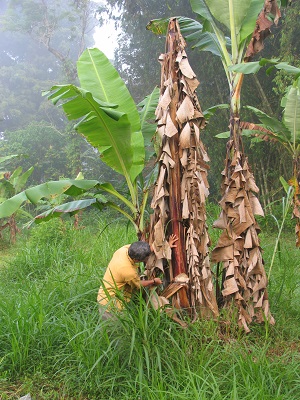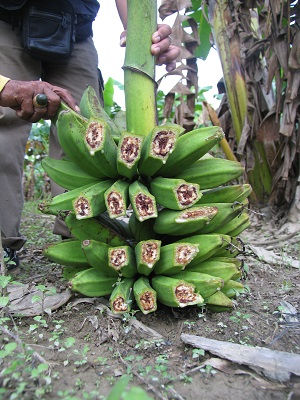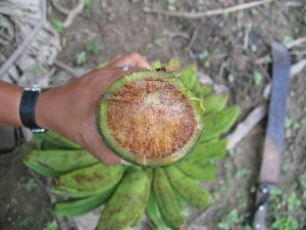
Blood disease
| Primefact number | Edition | Published | Author |
|---|---|---|---|
| 1330 | Second | Jul 2018 | Plant Biosecurity and Product Integrity |



Blood disease is caused by the blood disease bacterium (BDB) Ralstonia syzygii subsp. Celebesensis.
The blood disease bacterium is closely related to the bacterium that causes moko and bugtok (Pseudomonas solanacearum). These three bacterial diseases cause internal fruit discolouration.
These three banana diseases are not present in Australia.
Laboratory testing is required to reliably distinguish between these bacterial diseases.
Notifiable status
Blood disease in bananas is a notifiable plant disease in NSW.
All notifiable plant pests and diseases must be reported within 1 working day. You can report notifiable plant pests and diseases by one of the following methods:
- Call the Exotic Plant Pest Hotline 1800 084 881
- Email biosecurity@dpi.nsw.gov.au with a clear photo and your contact details
- Complete an online form
A full list of notifiable plant pests and diseases can be found in Schedule 2 of the NSW Biosecurity Act 2015.
Damage
Blood disease damages banana plants by invading the vascular tissue, causing them to wilt. Infected fruit is unmarketable.
Description
Blood disease causes yellowing and wilting of leaves. Infected leaves die and form a skirt around the plant stem (Figure 1). The banana plant wilts and dies.
Banana fruit may not appear externally to be infected, however when banana fingers are cut transversely, a red-brown dry rot of the fruit pulp is seen (Figure 2). Banana flowers when infected blacken or shrivel.
The internal plant symptom of blood disease is a red-brown discolouration of the vascular tissue. The discolouration extends throughout the infected banana plant (Figure 3).
Bacterial ooze from cut infected plant stems can vary in colour from milky to yellow to reddish-brown to black.
Spread
Short distance spread of blood disease occurs with the movement of infected plant parts, soil and water.
Insect transmission can occur from infected male flower buds to healthy male flower buds. The insect which transmits blood disease is not known. Infected farm implements and tools such as cutting knives can also spread blood disease.
Long distance spread of blood disease occurs through the movement of infected banana plant parts and planting material.
Hosts
The blood disease bacterium can infect cultivated and wild bananas (Musaceae plant family).
Distribution
Blood disease is endemic to Indonesia and has spread across Indonesia.
Actions to minimise risks
Put in place biosecurity best practice actions to prevent entry, establishment and spread of pests and diseases:
- practise “Come clean, Go clean”
- ensure all staff and visitors are instructed in and adhere to your business management hygiene requirements
- source propagation material of a known high health status from reputable suppliers
- monitor your crop regularly
- keep records
- isolate banana plants or areas with suspect symptoms to prevent further spread

